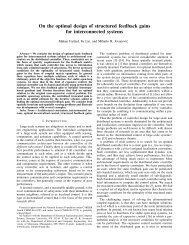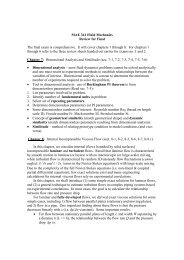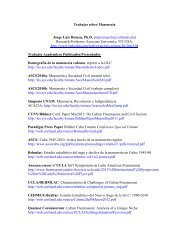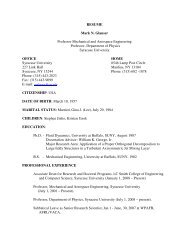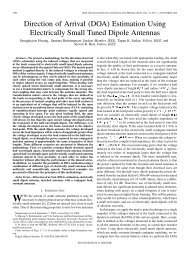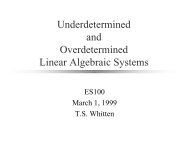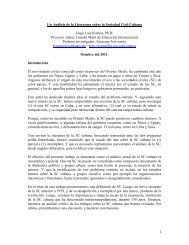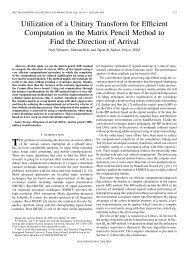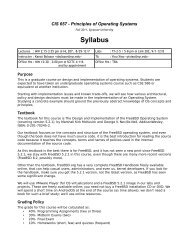Flow over a Magnetically Suspended Cylinder in an Axial Free Stream
Flow over a Magnetically Suspended Cylinder in an Axial Free Stream
Flow over a Magnetically Suspended Cylinder in an Axial Free Stream
You also want an ePaper? Increase the reach of your titles
YUMPU automatically turns print PDFs into web optimized ePapers that Google loves.
II. Experimental Set Up<br />
A. Magnetic Model Suspension, Force Bal<strong>an</strong>ce <strong>an</strong>d W<strong>in</strong>d Tunnel<br />
The experiment was conducted us<strong>in</strong>g the Magnetic Suspension <strong>an</strong>d Bal<strong>an</strong>ce System at the Institute of Space<br />
Technology <strong>an</strong>d Aeronautics, Jap<strong>an</strong> Aerospace Exploration Agency (formerly the National Aerospace Laboratory). The system<br />
was developed by the second author <strong>an</strong>d is described <strong>in</strong> Ref. 4. Figure 1 shows schematically the coil arr<strong>an</strong>gement used<br />
<strong>in</strong> the system, <strong>an</strong>d specifications of the <strong>in</strong>dividual coils are listed <strong>in</strong> Table 1. The position <strong>an</strong>d attitude of the model<br />
were monitored by two CCD cameras oriented perpendicular to each other. Two colors <strong>an</strong>d filters were used to<br />
separate reflected lights <strong>in</strong> two directions. The position was controlled at a feedback frequency of 248Hz. The magnet<br />
current was calibrated aga<strong>in</strong>st known force applied through pulleys <strong>an</strong>d weights for each model. The calibration was<br />
repeatable with<strong>in</strong> 0.02%. The models were made of alum<strong>in</strong>um alloy <strong>an</strong>d housed a rod-shaped magnet along their<br />
centerl<strong>in</strong>e. The bal<strong>an</strong>ce system was <strong>in</strong>stalled <strong>in</strong> the subsonic w<strong>in</strong>d tunnel with a 60cmx60cm test section. The available<br />
flow speed r<strong>an</strong>ges from 10 to 35 m/s. The free stream turbulence level was less th<strong>an</strong> 0.05%. The measured flow <strong>an</strong>gle<br />
at the center is 0.05 degree <strong>in</strong> downwash <strong>an</strong>d 0.15 degree about z-axis shown <strong>in</strong> Fig. 1. Further detail of the MSBS <strong>an</strong>d<br />
the w<strong>in</strong>d tunnel c<strong>an</strong> be found <strong>in</strong> Ref. 4.<br />
model<br />
coil # turn number size purposes<br />
0,9 50 620 x 620 drag<br />
1,3,5,7 97 + 97 200 x 200 lift,<br />
pitch moment<br />
side force ,<br />
yaw<strong>in</strong>g moment,<br />
roll<strong>in</strong>g moment<br />
130V, 120A <strong>in</strong> cont<strong>in</strong>uous mode … 3 units<br />
130V, 60A <strong>in</strong> cont<strong>in</strong>uous mode … 4 units<br />
5 DOF for models with a ma<strong>in</strong> magnet only<br />
6 DOF for special models with pair magnets<br />
2,4,6,8 100 200 x 200<br />
coil drive<br />
units<br />
control<br />
Table 1 Specifications of the 60cm MSBS (Ref. 4)<br />
position sens<strong>in</strong>g camera<br />
Fig. 1 MSBS coil arr<strong>an</strong>gement (not to scale,<br />
only one camera is shown)<br />
B. Test Models<br />
Figures 2 illustrates cyl<strong>in</strong>drical models supported magnetically <strong>in</strong> the test section. In addition to the model edges, the<br />
sens<strong>in</strong>g cameras use a vertical stripe <strong>in</strong> the middle to detect the model position <strong>an</strong>d attitude. Inst<strong>an</strong>t<strong>an</strong>eous model position<br />
was monitored <strong>an</strong>d held with<strong>in</strong> ±0.2mm. In order to provide a wide r<strong>an</strong>ge of the f<strong>in</strong>eness ratio, models with different<br />
diameters were used. One had 45mm diameter <strong>an</strong>d shared the same center section enclos<strong>in</strong>g the magnet. By ch<strong>an</strong>g<strong>in</strong>g the end<br />
caps of different lengths, n<strong>in</strong>e f<strong>in</strong>eness ratios between 4.13 <strong>an</strong>d 8.13 were achieved. Second set of model had a diameter of<br />
85mm <strong>an</strong>d the third 110mm. These larger diameter models provided the f<strong>in</strong>eness ratio down to 1.272. An additional model of<br />
25mm diameter <strong>an</strong>d f<strong>in</strong>eness ratio of 6 was also used. The Reynolds number based on the diameter r<strong>an</strong>ged from 60,000 to<br />
100,000.<br />
- 2 –<br />
Americ<strong>an</strong> Institute of Aeronautics <strong>an</strong>d Astronautics




